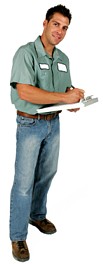Introduction to Earwigs
Earwigs, in the order Dermaptera, are a common type of insect and are seen as a pest by many people. Earwigs are also called pincher bugs, in reference to their pincher like appendages, but they do not contain poison. Although earwigs are not known to harm humans or pets, and do not transmit disease, they can damage plants by feeding on leaves.
If there are not too many earwigs, it is all right to just let them be. In fact, earwigs actually feed on other more harmful insects. However, if there is a large infestation of earwigs, they can do damage to a garden, by feeding on plants by night. Birds enjoy eating earwigs, so attracting birds to the garden can decrease the earwig population.
One way to deal with earwigs is to capitalize on their love of cool moist areas. A damp newspaper can be rolled up and placed in the area of the garden that is infested by earwigs. The earwigs congregate in the damp newspapers, which can then be collected and disposed of. Since earwigs like moist areas, they congregate around the foundations of houses. Adding gravel or stones around the foundation to increase drainage can cause earwigs to be less attracted to your foundation.
Windows on the ground level and drafty or loose doors can let earwigs into the house. Making sure that the screens on windows are in good repair and that all cracks around windows and doors are sealed will help keep earwigs out of the house. This can be done by using weather stripping, putty, or caulk.
Boric acid can get rid of earwigs inside or outside. Boric acid powder is a residual insecticide, which means that the insecticide will persist after the insect makes contact with it. Spreading boric acid around cracks and baseboards, so that the insects are forced to travel through the powder will cause this natural insecticide to destroy the earwigs.
 Earwigs are also attracted to vegetable oil, which can be utilized to remove them from the garden. A pie tin or some other type of shallow dish can be filled with vegetable oil, and then buried up to the rim in the dirt. Since the vegetable oil is now at ground level, the earwigs become attracted to the oil and walk right into the pan.
Earwigs are also attracted to vegetable oil, which can be utilized to remove them from the garden. A pie tin or some other type of shallow dish can be filled with vegetable oil, and then buried up to the rim in the dirt. Since the vegetable oil is now at ground level, the earwigs become attracted to the oil and walk right into the pan.
If there is a large population of earwigs in your house, it is possible to just vacuum them up. The vacuum should be ready and placed near the earwigs' resting area before it is turned on, because they will quickly run away. The earwig eggs should be vacuumed up also and everything disposed of in a sealed container.
Written by Bronwyn Harris
Related Home Institute Articles
